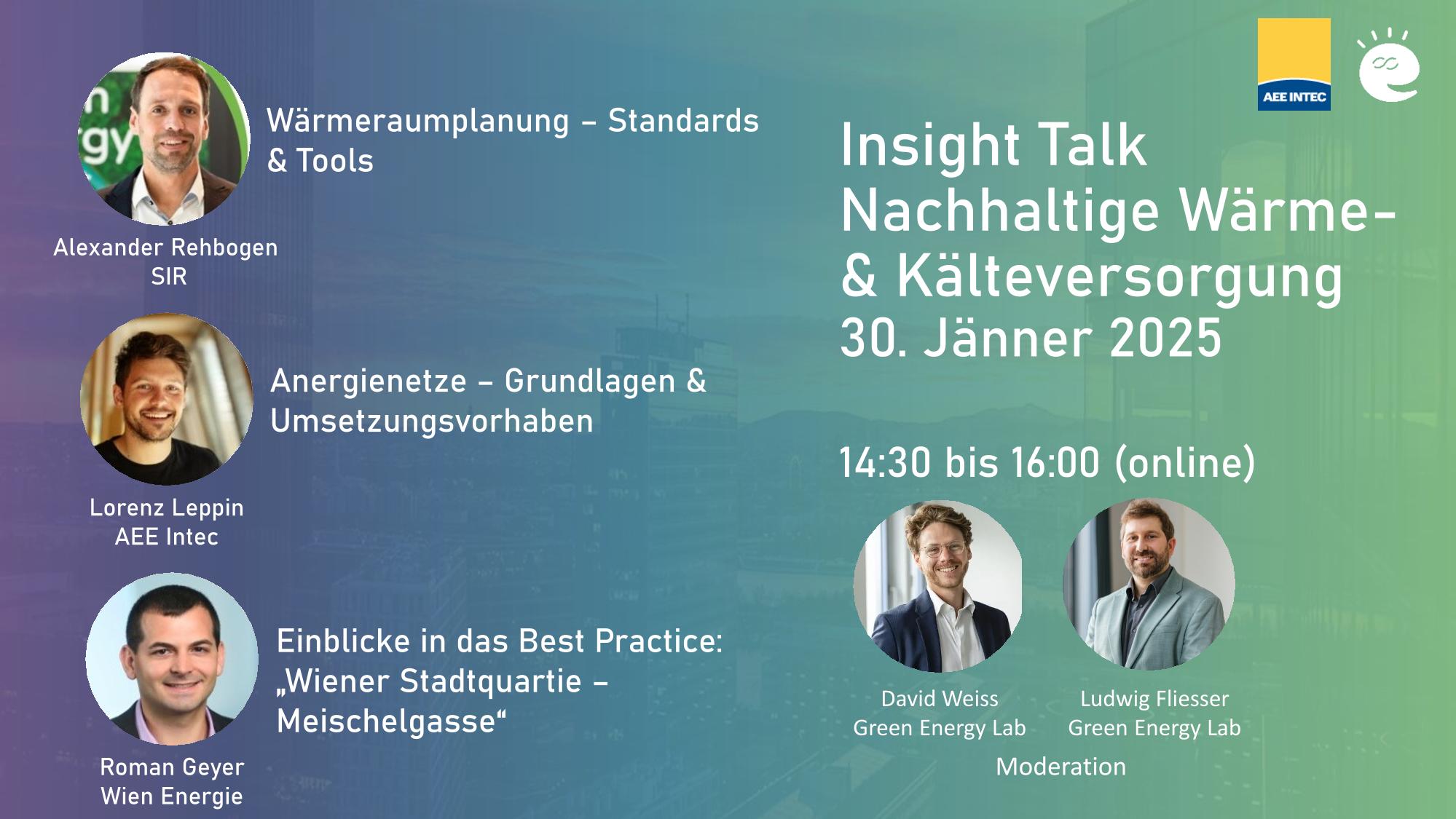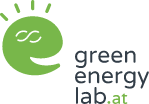Sustainable heating and cooling supply as an important component of the energy transition
At the Insight Talk organised by Green Energy Lab together with AEE INTEC on 30 January 2025, renowned experts presented options for a climate-neutral heating and cooling supply for buildings and districts.

19 February 2025 – The heating sector is responsible for around half of final energy consumption in Austria and the majority of this energy still comes from fossil sources. A successful energy transition therefore requires, above all, a heating transition.
The supply of heating and cooling to buildings and districts is a particularly important lever for transforming the heating sector towards sustainable energy sources. Green Energy Lab and AEE INTEC collaborated on this key topic and organised an Insight Talk on the sustainable heating and cooling supply of the future. Innovative technologies for the use of green heating and cooling in buildings and districts were presented. Renowned experts presented solutions that can make a concrete contribution to sustainable spatial heat planning as well as local and district heating.
Insights into spatial heat planning – perspectives and developments
Alexander Rehbogen from the Salzburger Institut für Raumplanung (SIR, Salzburg Institute for Spatial Planning) provided valuable insights into spatial heat planning and emphasised the importance of solid spatial information for the development of customised solutions. Together with partners from all over Austria, intensive work is being carried out to drive forward spatial heat planning. While heat supply, electricity and mobility are important factors in spatial energy planning, the focus is particularly on spatial heat planning, as this is the most relevant from a sovereign point of view.
Framework conditions at EU level
With its directives, the European Union is providing important impetus for spatial heat planning:
- EU Energy Efficiency Directive (EED III) – Article 25
→ Assessment and planning of the heating and cooling supply
→ Member States must ensure that municipalities with more than 45,000 inhabitants draw up local heating and cooling supply plans. - EU Energy Efficiency Directive (EED III) – Article 26
→ Definition of efficient district heating and cooling systems
→ Obligation to gradually increase the share of renewable energy sources
Role models: Denmark and Germany
Austria is drawing on the experience of Denmark and Germany in order to further develop efficient spatial heat planning and create innovative solutions for new build and renovation areas. A key challenge is to adapt existing subsidies and regulations in order to enable the expansion of low-temperature networks, for example.
In Denmark, the aim is to cover around 80 percent of heating requirements with district heating by 2050. The proportion of biomass, whose potential has largely been exhausted, will be gradually reduced. Instead, the focus is shifting to heat pumps as the primary source of heat. This development requires continuous adaptation of the infrastructure and targeted support measures.
Germany is taking a clear step towards a climate-friendly heat supply with the Gebäudeenergiegesetz (GEG, Building Energy Act). From 2024 or 2026, only heating systems that use at least 65 percent renewable energy may be installed in new buildings. In addition, the Heat Planning Act makes municipal heat planning mandatory: municipalities with more than 10,000 inhabitants must draw up heat plans. In addition, Germany offers a central point of contact for expertise, groundwork and strategic communication of the heating transition with its competence centre for the municipal heating transition.
Heat planning in Austria
Strategic heat planning is also becoming increasingly important in Austria. With its Wärmeplan 2040 (heating plan), the City of Vienna is focussing on detailed zoning of built-up areas in order to specifically identify alternatives to fossil fuels such as oil and gas. These measures are intended to ensure a sustainable and efficient heat supply.
A model example in Austria is Styria, which has already anchored key regulations in its Spatial Planning Act. This enables structured and long-term planning that facilitates the transition to renewable energies.
The Energy Atlas also supports spatial heat planning by collating spatial energy data in a bottom-up approach. For example, data on oil boilers (number, age, output) can be recorded and targeted measures can be derived on this basis. This provides citizens, municipalities and regional governments with valuable insights and enables them to independently determine their individual requirements.
Another innovative tool is the Energie-Kompass Salzburg (Salzburg Energy Compass), which provides information on innovative heating networks at the touch of a button. By entering an address, users can call up possible connection options and contacts for installers. These digital tools make a significant contribution to the practical and efficient implementation of spatial heat planning in Austria.
> Insight Talk: Local and district heating solutions >> Click here for the report on the Insight Talk “Local and district heating solutions in regional spatial heat planning”!
Innovative anergy grid technologies – insights and practical examples
Lorenz Leppin (AEE INTEC) presented pioneering anergy grid technologies and showed practical examples of how low-temperature grids contribute to energy saving and sustainable heat supply. Anergy grids, which operate non-directionally and can both extract and feed in energy, offer numerous advantages such as low transport losses, efficient integration of regenerative energy sources (e.g. waste heat, solar thermal energy, PVT modules) and utilisation as cooling in summer.
Practical examples:
- FGZ Zürich – Project DeStoSimKaFe: In this project, an anergy network is operated with over 5,000 consumers. Waste heat from data centres and decentralised heat pumps ensure efficient heat distribution. Seasonal storage is provided by a geothermal probe field.
- Amstetten – Project AMSL 2023: Here, the revitalisation of the city centre is being driven forward with the construction of new office and residential complexes. Various thermal supply concepts, including anergy networks, have led to lower heat losses and additional energy gains through geothermal energy.
- Herzogenburg – Garten der Generationen (Project Anergy2Plus): An integrative residential district relies on decentralised heat pumps, short-term storage, boreholes and foundation storage as well as solar thermal collectors for a sustainable heat supply.
These practical examples show the potential of anergy grids to enable sustainable and efficient energy distribution and to integrate different energy sources in a meaningful way.
District solutions in Vienna – the best practice example of Meischlgasse
Roman Geyer from Wien Energie presented Vienna’s Meischlgasse district as an outstanding best practice example of modern and sustainable heat supply. The district embodies a future-oriented solution that integrates numerous innovative approaches to the heating transition and serves as a showcase project for climate-neutral urban development in Vienna. Vienna is pursuing the ambitious goal of becoming climate-neutral by 2040, with integrated heating solutions playing a central role.
Key aspects of integrated heating solutions
Heat network systems offer high efficiency by creating synergies between waste heat utilisation and heat demand. Possible solutions include:
- District heating networks
- Source networks
- Cold local heating networks (anergy)
- Combinations of these systems for a customised, needs-based energy supply
The different designs of these systems (temperature level, supply, pressure, materials and pipe dimensions) mean that various requirements and conditions can be optimally taken into account. The integration of new technologies is particularly easy to implement in new buildings, while existing infrastructures need to be adapted.
Consideration of location resources
Various local resources are crucial for sustainable district planning:
- District heating
- Waste heat
- Geothermal energy
- Thermal groundwater utilisation
- Solar energy
- Air heat
These diverse resources are specifically combined to ensure an efficient and environmentally friendly energy mix.
Development process – important considerations and planning
Before a district can be realised, fundamental questions about the energy supply and the specific needs of future users must be clarified. The following aspects are crucial here:
- Which energy sources are to be used?
- What type of use is envisaged (e.g. residential district)?
- What is the specific demand (e.g. for heating, hot water, cooling)?
Wien Energie uses advanced simulation programs to plan and optimise the energy supply. These enable precise modelling of the energy flows even before construction begins, which enables efficient integration of the entire energy mix and thus guarantees a sustainable and future-proof supply.
Conclusion: The Meischlgasse district project impressively demonstrates how an efficient, sustainable and climate-friendly heat supply can be achieved through targeted planning, the integration of innovative technologies and the consideration of local resources. This model provides valuable insights for the development of further climate-neutral districts and contributes to the realisation of Vienna’s goal of becoming climate-neutral by 2040.
Background information
The building sector is responsible for around 50 % of total energy consumption in Austria. A sustainable heating and cooling supply is therefore a key lever for achieving climate targets. New technologies and optimised data bases in spatial heat planning can help to significantly reduce this energy consumption. In particular, anergy networks, also known as low-temperature networks, play a decisive role here.
Spatial heat planning is a strategic planning tool for efficient and sustainable heat supply in cities and regions. By analysing energy requirements, available resources and infrastructural conditions, tailor-made solutions for a climate-friendly heat supply can be developed. Reliable data and digital tools for optimising planning processes are particularly important here.
(General networks include district heating and local heating networks that supply buildings or districts with centrally generated heat. These networks utilise various energy sources such as biomass, geothermal energy or waste heat to ensure a stable and sustainable supply.)
Anergy networks are special low-temperature networks that rely on the utilisation of waste heat, environmental heat and renewable sources. They transport heat at a low temperature level (e.g. 10-30°C) and enable flexible use for heating and cooling through decentralised heat pumps. Anergy networks are particularly efficient and enable a high level of integration of renewable energies. These concepts could contribute significantly to the reduction of CO₂ emissions and the sustainable transformation of the energy sector.
All presentations for download and as a video to watch
- Alexander Rehbogen – SIR Salzburger Institut für Raumplanung_30.01.2025 – German only
- Lorenz Leppin – AEE INTEC – Anergy networks 30.01.2025 – German only
- Roman Geyer – WIEN ENERGIE – District Meischlgasse 30.01.2025 – German only
You are currently seeing a placeholder content of YouTube. To access the actual content, click on the button below. Please note that data will be passed on to third-party providers.
Contact
Ludwig Fliesser
Communications Manager
T: +43 676 471 93 47
E: ludwig.fliesser@greenenergylab.at
